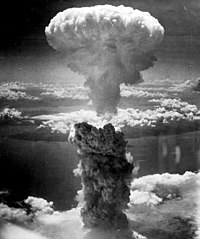
A nuclear weapon (sometimes called a nuclear bomb) is a type of weapon of mass destruction and an explosive device that derives its destructive force from nuclear reactions (either fission or a combination of fission and fusion). Both reactions release vast quantities of energy from relatively small amounts of matter; a modern thermonuclear weapon weighing little more than a thousand kilograms can produce an explosion comparable to the detonation of more than a billion kilograms of conventional high explosive.[1] Even small nuclear devices with yields equivalent to several thousand tons of TNT can devastate a city. Nuclear weapons are considered weapons of mass destruction, and their use and control has been a major aspect of international policy since their debut in Nagasaki and Hiroshima.
In the history of warfare, only two nuclear weapons have been detonated offensively, both during the closing days of World War II. The first was detonated on the morning of August 6, 1945, when the United States dropped a uranium gun-type device code-named "Little Boy" on the Japanese city of Hiroshima. The second was detonated three days later on August 9, 1945, when the United States dropped a plutonium implosion-type device code-named "Fat Man" on the city of Nagasaki, Japan. These bombings resulted in the immediate deaths of around 120,000 people (mostly civilians) from injuries sustained from the explosion and acute radiation sickness, and even more deaths from long-term effects of (ionizing) radiation. The use of these weapons was and remains controversial. (See atomic bombings of Hiroshima and Nagasaki for a full discussion.)
Since the Hiroshima and Nagasaki bombings, nuclear weapons have been detonated on over two thousand occasions for testing purposes and demonstration purposes. The only countries known to have detonated nuclear weapons – and that acknowledge possessing such weapons – are (chronologically) the United States, the Soviet Union (succeeded as a nuclear power by Russia), the United Kingdom, France, the People's Republic of China, India, Pakistan, and North Korea. Israel is also widely believed to possess nuclear weapons, though it does not acknowledge having them. For more information on these states' nuclear programs, as well as other states that formerly possessed nuclear weapons or are suspected of seeking nuclear weapons, see List of states with nuclear weapons.
Post-attack casualties
According to most estimates, the immediate effects of the blast of the bombing of Hiroshima killed approximately 70,000 people. Estimates of total deaths by the end of 1945 from burns, radiation and related disease, the effects of which were aggravated by lack of medical resources, range from 90,000 to 140,000. Some estimates state up to 200,000 had died by 1950, due to cancer and other long-term effects. From 1950 to 1990, roughly 9% of the cancer and leukemia deaths among bomb survivors was due to radiation from the bombs. At least eleven known prisoners of war died from bombing.
the Announcement of the bombing in audio
The energy released by the bomb was
powerful enough to burn through clothing.
The dark portions of the garments this
victim wore at the time of the blast were
emblazoned on to the flesh as scars,
while skin underneath the lighter parts
(which absorb less energy)
was not damaged as badly
